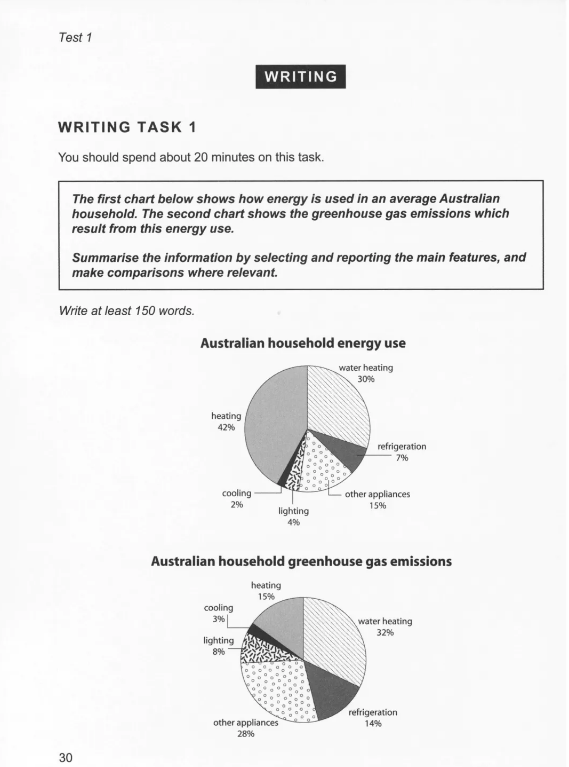* 饼图,选自《剑桥雅思真题集10》

Shown in the pair of pie charts are the use of energy of an average Australian household and the emission of greenhouse gas ensuing from it.
* 注意开头处的倒装现象。
* 注意词汇:不及物动词ensue (from)。
Energy is predominantly used for heating, whose use of energy accounts for 42% of a household’s total consumption. Water heating – using 30% of the total energy – is the second largest energy user. These two users contrast sharply with all others – cooling, lighting, refrigeration, and other appliances – whose energy use range from 2% to 15%.
* 三句话就可以写完第 一个饼。
* 第 一句话注意主语的选择:energy。因为用了这个主语,句子的内容逻辑就避免了流水账,即“什么项目用了多少能量”。然后用非限定性定语从句补充说明百分比。
* 第二句用了常规主语,但是为了避免流水账(“什么项目用了多少能量”),把介绍百分比的部分写成了状语插入的语法形式,于是主句表达的是“water heating是第二大能耗项目”。同时“第二大”这个表达构建了与上一句之间的联系,拿到CC文脉分。
* 第三句主语是指代,于是就把前两句话和第三句话构建了联系,拿到CC文脉分。在宾语处用同位语把图中出现的项目介绍全。然后定语从句修饰all others,同时用“区间写法”避免罗列数字。
* 词汇上注意“users”,类似拟人。
Of all those energy users, two major emitters of greenhouse gas are water heating and other appliances. Their emissions account for 32% and 28% respectively, and either percentage roughly equals that of the emissions of heating and refrigeration combined. It is also noteworthy that greenhouse gas emitted by heating and by refrigeration is of almost the same amount. In addition, cooling and lighting are not only the smallest energy users but also the smallest greenhouse gas emitters.
* 主语的多样:四个句子的主语各不相同。
* 避免流水账,即罗列“什么项目用了多少能量”。尤其注意第二句的后半句,把前后两句话建立了联系。
* 第三句是形式主语替代主语从句。
* 词汇上注意“emitters”,类似拟人。
Overall, the differences are apparent between one item and another in both the usage of energy and the emission of greenhouse gas.
0元领取剑桥雅思系列真题解析、托福TPO、SAT考试真题,更多独家资料免费领取。
